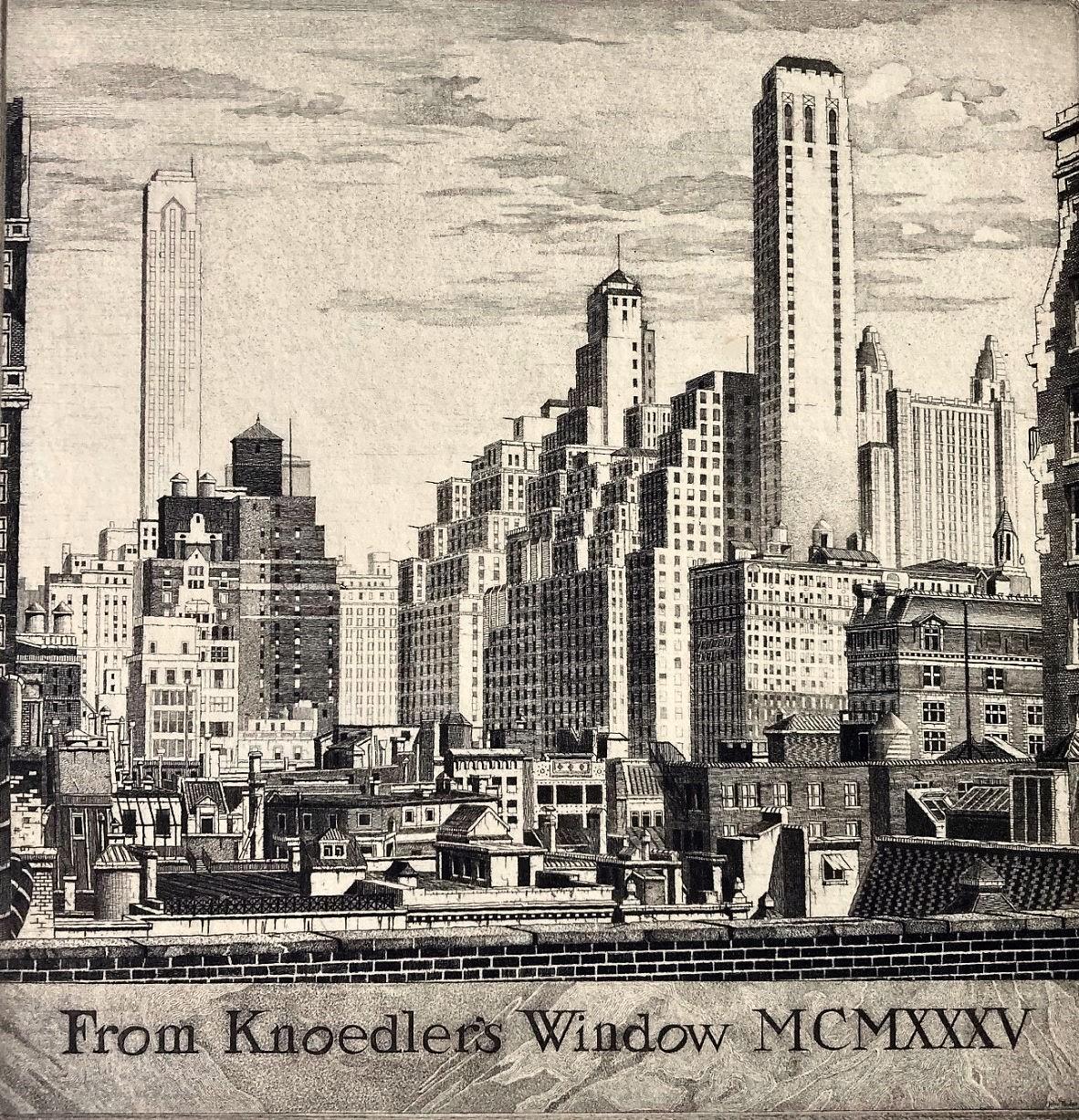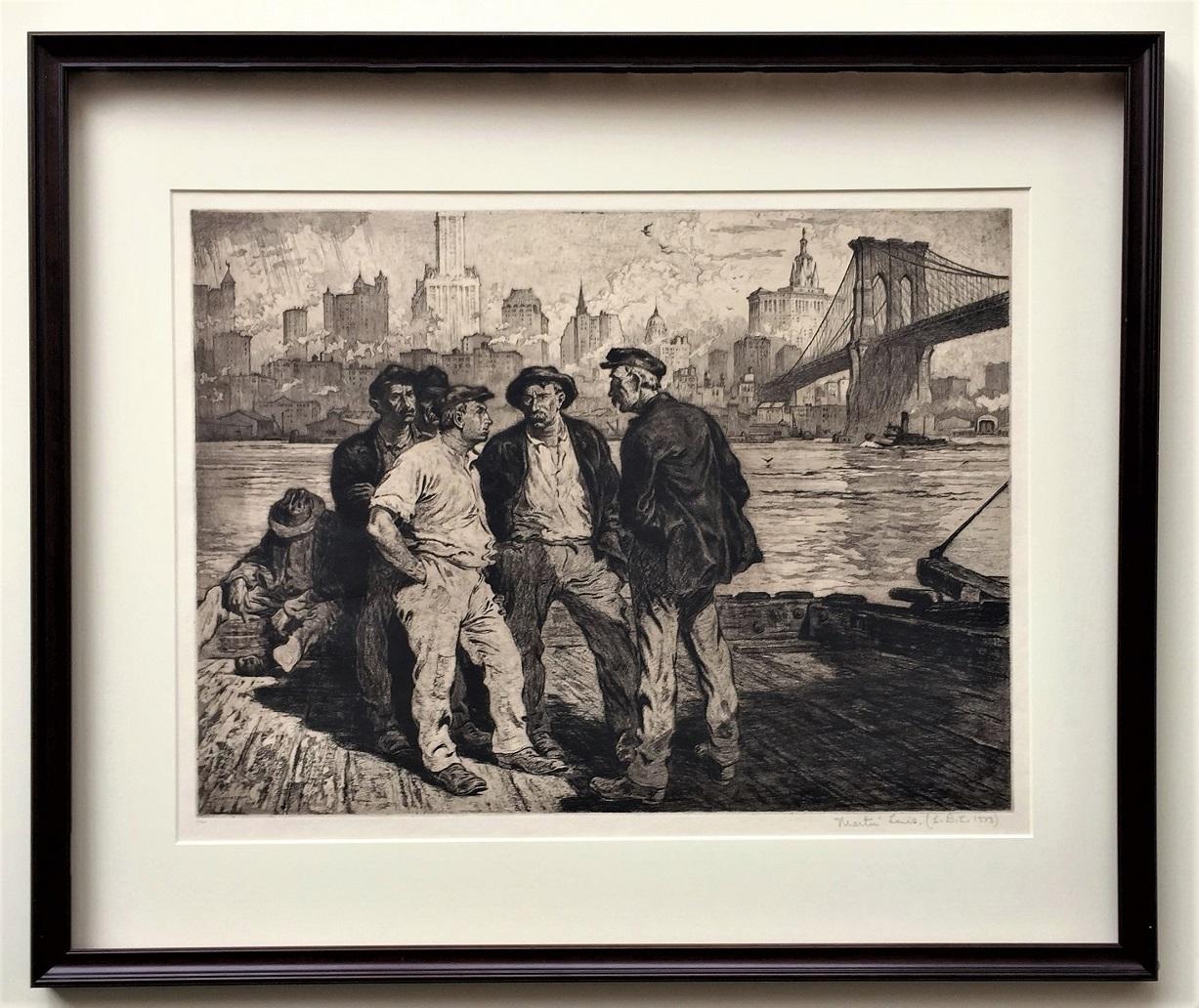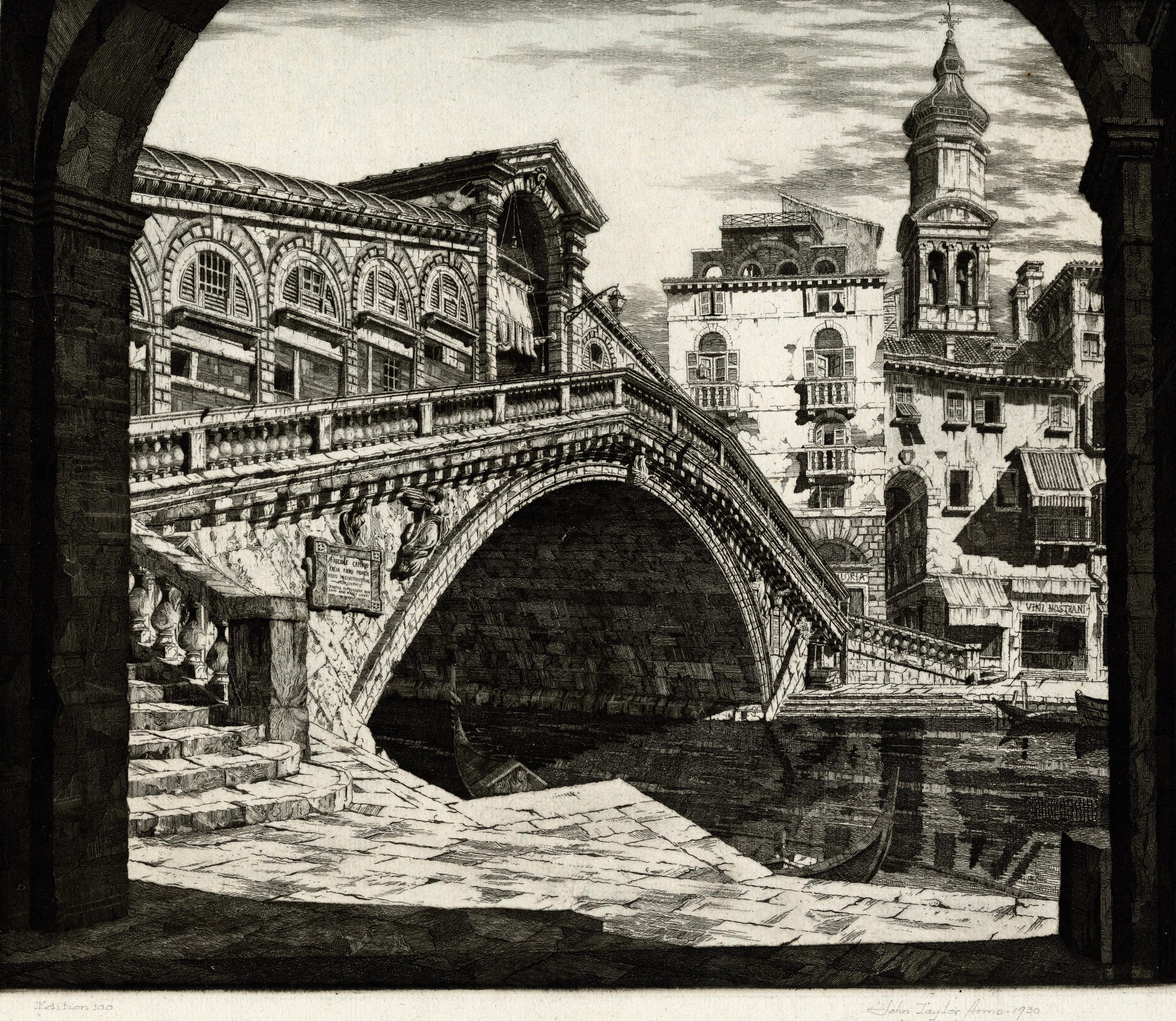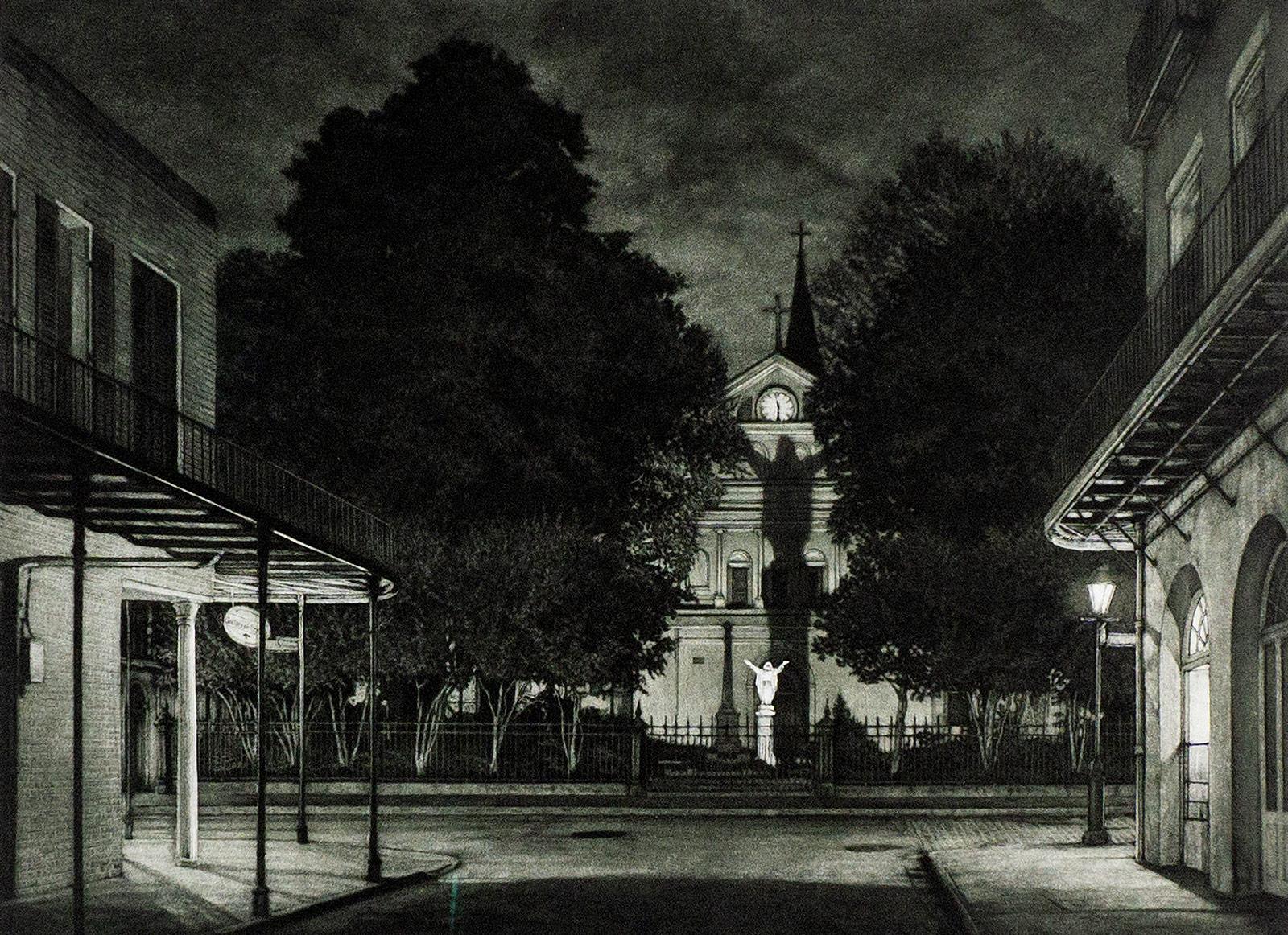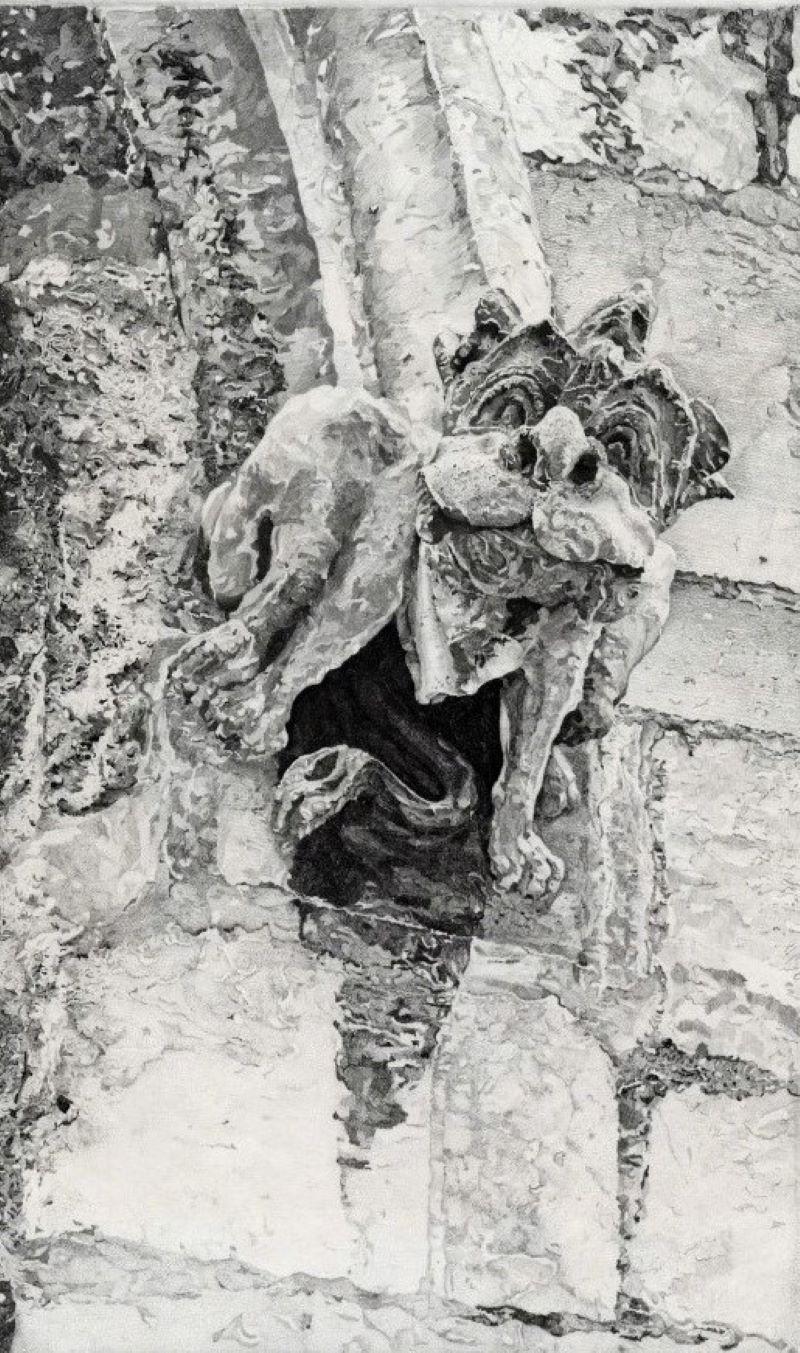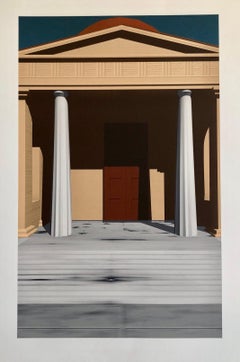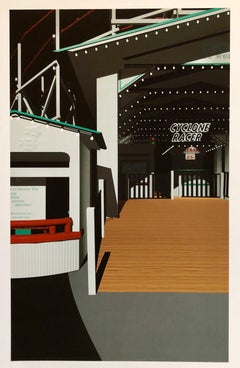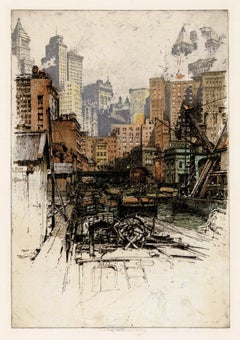
Lower East Side Tenements Yiddish Barber Shop 1920's Aquatint Etching Judaica
View Similar Items
Want more images or videos?
Request additional images or videos from the seller
1 of 6
Max PollakLower East Side Tenements Yiddish Barber Shop 1920's Aquatint Etching Judaica1929
1929
About the Item
- Creator:Max Pollak (1886 - 1970, Austrian)
- Creation Year:1929
- Dimensions:Height: 15 in (38.1 cm)Width: 9.5 in (24.13 cm)
- Medium:
- Movement & Style:
- Period:
- Condition:mat has wear. 8 7/8 x 4 3/4" platemark. mat measures 15 x 9.5.
- Gallery Location:Surfside, FL
- Reference Number:1stDibs: LU3823574871
About the Seller
4.9
Platinum Seller
These expertly vetted sellers are 1stDibs' most experienced sellers and are rated highest by our customers.
Established in 1995
1stDibs seller since 2014
1,539 sales on 1stDibs
Typical response time: 1 hour
More From This SellerView All
- Lower East Side Tenements Yiddish Barber Shop 1920's Aquatint Etching JudaicaBy Max PollakLocated in Surfside, FLHand signed, numbered and titled. It depicts the old lower east side of New York city with its tenements and different language signes, barber shop poles...Category
1920s American Modern Landscape Prints
MaterialsEtching, Aquatint
- Location Proposal Iris Print Ed. 12 Architectural Study LA CAlifornia ModernistBy Cindy BernardLocated in Surfside, FLCindy Bernard’s career spans nearly three decades and she is best known for photographs and projections that explore the relationship between cinema, memory, and landscape including the widely exhibited series Ask the Dust (1988-92), now in the collections of the Museum of Contemporary Art, Los Angeles (21 part set), the Pompidou, MOMA and the Whitney Museum of American Art. She is a recipient of grants and fellowships from the J. Paul Getty Trust Fund for the Visual Arts, California Arts Council, Creative Capital, Anonymous Was a Woman, the Harpo Foundation, California Community Foundation, the John Simon Guggenheim Memorial Foundation and the MacDowell Colony. Her work has been exhibited in museums and galleries in the US, Canada, Mexico, Europe, and Japan, and was included in the Whitney and Lyon Biennials. In addition to her visual practice, Bernard takes an active interest in the spaces and production of social exchange. She was a director and advisor to Foundation for Art Resources from 1985 to 1990, a founding director of the Coalition for Freedom of Expression, and co-founder of MOCA Mobilization. Bernard is also the founder and director of The Society for the Activation of Social Space through Art and Sound (SASSAS), an organization she began in response to the need for a flexible and sustainable association dedicated to experimental music in Los Angeles. She has curated and produced more than 50 concerts for SASSAS including Welcome Inn Time Machine for Pacific Standard Time in 2012. Her interest in sound has spurred several projects including a series of photographs of municipal band shells which Bernard sees as an architecture of public exchange and The Inquisitive Musician, an adaptation of a 17th century German satire, Musicus Curiosus, or Battalus, the Inquisitive Musician; the Struggle for Precedence between the Kunst Pfeifer and the Common Players. The Inquisitive Musician pits itinerant “beer fiddlers” against the city sanctioned “Kunstpfeifer” in an argument over who has the right to perform and be compensated. Presented as a staged reading incorporating video and live music, The Inquisitive Musician has been performed in New York, in Los Angeles at the LA County Museum of Art, and most recently at the Stedelijk Museum in Amsterdam in June 2013. Current projects include Vinland, a meditation on the complex and continually shifting relationships between spaces, social and economic structures, and personal and collective histories and, more recently, an “episodic” series based on the history of social nudism: Your Personal View of (Social) Nudism. Bernard is a Adjunct Professor of Graduate Fine Art at Art Center College of Art and Design and was appointed the inaugural Ruffin Distinguished Artist-In-Residence at the University of Virginia for the academic year 2013/2014. She was a 2016 National Endowment for the Arts Fellow at the MacDowell Colony and will be in residence at the UCross Foundation in 2017. Muse X Editions. An (now defunct) LA based innovative publisher of limited-edition prints, Muse X has launched its first group of prints and is just beginning to make itself known to artists, curators, dealers and collectors. Among works just off the press are otherworldly landscapes by Barbara Kasten and Oliver Wasow, a sizzling sunset by Peter Alexander, abstract compositions by Pauline Stella Sanchez and Jennifer Steinkamp, text and photo combinations by Bill Barminski and Nancy Dwyer...Category
1990s American Modern Landscape Prints
MaterialsColor
- Location Proposal Iris Print Ed. 12 Hand Signed Cyclone Racer (Coney Island, NY)By Cindy BernardLocated in Surfside, FLCindy Bernard’s career spans nearly three decades and she is best known for photographs and projections that explore the relationship between cinema, memory, and landscape including ...Category
1990s American Modern Landscape Prints
MaterialsColor
- Location Proposal Iris Print Ed. 12 Hand Signed Architectural StudyBy Cindy BernardLocated in Surfside, FLCindy Bernard’s career spans nearly three decades and she is best known for photographs and projections that explore the relationship between cinema, memory, and landscape including the widely exhibited series Ask the Dust (1988-92), now in the collections of the Museum of Contemporary Art, Los Angeles (21 part set), the Pompidou, MOMA and the Whitney Museum of American Art. She is a recipient of grants and fellowships from the J. Paul Getty Trust Fund for the Visual Arts, California Arts Council, Creative Capital, Anonymous Was a Woman, the Harpo Foundation, California Community Foundation, the John Simon Guggenheim Memorial Foundation and the MacDowell Colony. Her work has been exhibited in museums and galleries in the US, Canada, Mexico, Europe, and Japan, and was included in the Whitney and Lyon Biennials. In addition to her visual practice, Bernard takes an active interest in the spaces and production of social exchange. She was a director and advisor to Foundation for Art Resources from 1985 to 1990, a founding director of the Coalition for Freedom of Expression, and co-founder of MOCA Mobilization. Bernard is also the founder and director of The Society for the Activation of Social Space through Art and Sound (SASSAS), an organization she began in response to the need for a flexible and sustainable association dedicated to experimental music in Los Angeles. She has curated and produced more than 50 concerts for SASSAS including Welcome Inn Time Machine for Pacific Standard Time in 2012. Her interest in sound has spurred several projects including a series of photographs of municipal band shells which Bernard sees as an architecture of public exchange and The Inquisitive Musician, an adaptation of a 17th century German satire, Musicus Curiosus, or Battalus, the Inquisitive Musician; the Struggle for Precedence between the Kunst Pfeifer and the Common Players. The Inquisitive Musician pits itinerant “beer fiddlers” against the city sanctioned “Kunstpfeifer” in an argument over who has the right to perform and be compensated. Presented as a staged reading incorporating video and live music, The Inquisitive Musician has been performed in New York, in Los Angeles at the LA County Museum of Art, and most recently at the Stedelijk Museum in Amsterdam in June 2013. Current projects include Vinland, a meditation on the complex and continually shifting relationships between spaces, social and economic structures, and personal and collective histories and, more recently, an “episodic” series based on the history of social nudism: Your Personal View of (Social) Nudism. Bernard is a Adjunct Professor of Graduate Fine Art at Art Center College of Art and Design and was appointed the inaugural Ruffin Distinguished Artist-In-Residence at the University of Virginia for the academic year 2013/2014. She was a 2016 National Endowment for the Arts Fellow at the MacDowell Colony and will be in residence at the UCross Foundation in 2017. Muse X Editions. An (now defunct) LA based innovative publisher of limited-edition prints, Muse X has launched its first group of prints and is just beginning to make itself known to artists, curators, dealers and collectors. Among works just off the press are otherworldly landscapes by Barbara Kasten and Oliver Wasow, a sizzling sunset by Peter Alexander, abstract compositions by Pauline Stella Sanchez and Jennifer Steinkamp, text and photo combinations by Bill Barminski and Nancy Dwyer...Category
1990s American Modern Landscape Prints
MaterialsColor
- Modernist Silkscreen Screenprint 'El Station, Interior' NYC Subway, WPA ArtistBy Anthony VelonisLocated in Surfside, FLscreenprint printed in color ink on wove paper. New York City subway station interior. Anthony Velonis (1911 – 1997) was an American painter and designer born in New York City who helped introduce the public to silkscreen printing in the early 20th century. While employed under the federal Works Progress Administration, WPA during the Great Depression, Velonis brought the use of silkscreen printing as a fine art form, referred to as the "serigraph," into the mainstream. By his own request, he was not publicly credited for coining the term. He experimented and mastered techniques to print on a wide variety of materials, such as glass, plastics, and metal, thereby expanding the field. In the mid to late 20th century, the silkscreen technique became popular among other artists such as Robert Rauschenberg and Andy Warhol. Velonis was born into a relatively poor background of a Greek immigrant family and grew up in the tenements of New York City. Early on, he took creative inspiration from figures in his life such as his grandfather, an immigrant from the mountains in Greece, who was "an ecclesiastical painter, on Byzantine style." Velonis attended James Monroe High School in The Bronx, where he took on minor artistic roles such as the illustration of his high school yearbook. He eventually received a scholarship to the NYU College of Fine Arts, into which he was both surprised and ecstatic to have been admitted. Around this time he took to painting, watercolor, and sculpture, as well as various other art forms, hoping to find a niche that fit. He attended NYU until 1929, when the Great Depression started in the United States after the stock market crash. Around the year 1932, Velonis became interested in silk screen, together with fellow artist Fritz Brosius, and decided to investigate the practice. Working in his brother's sign shop, Velonis was able to master the silkscreen process. He reminisced in an interview three decades later that doing so was "plenty of fun," and that a lot of technology can be discovered through hard work, more so if it is worked on "little by little." Velonis was hired by Mayor LaGuardia in 1934 to promote the work of New York's city government via posters publicizing city projects. One such project required him to go on a commercial fishing trip to locations including New Bedford and Nantucket for a fortnight, where he primarily took photographs and notes, and made sketches. Afterward, for a period of roughly six months, he was occupied with creating paintings from these records. During this trip, Velonis developed true respect and affinity for the fishermen with whom he traveled, "the relatively uneducated person," in his words. Following this, Velonis began work with the Public Works of Art Project (PWAP), an offshoot of the Civil Works Administration (CWA), where he was assigned to serve the different city departments of New York. After the formation of the federal Works Progress Administration, which hired artists and sponsored projects in the arts, he also worked in theater. Velonis began working for the federal WPA in 1935. He kept this position until 1936 or 1938, at which point he began working in the graphic art division of the Federal Art Project, which he ultimately led. Under various elements of the WPA program, many young artists, writers and actors gained employment that helped them survive during the Depression, as well as contributing works that created an artistic legacy for the country. When interviewed in December 1994 by the Library of Congress about his time in the WPA, Velonis reflected that he had greatly enjoyed that period, saying that he liked the "excitement" and "meeting all the other artists with different points of view." He also said in a later interview that "the contact and the dialogue with all those artists and the work that took place was just invaluable." Among the young artists he hired was Edmond Casarella, who later developed an innovative technique using layered cardboard for woodcuts. Velonis introduced silkscreen printing to the Poster Division of the WPA. As he recalled in a 1965 interview: "I suggested that the Poster division would be a lot more productive and useful if they had an auxiliary screen printing project that worked along with them. And apparently this was very favorably received..." As a member of the Federal Art Project, a subdivision of the WPA, Velonis later approached the Public Use of Arts Committee (PUAC) for help in "propagandizing for art in the parks, in the subways, et cetera." Since the Federal Art Project could not be "self-promoting," an outside organization was required to advertise their art more extensively. During his employment with the Federal Art Project, Velonis created nine silkscreen posters for the federal government. Around 1937-1939 Velonis wrote a pamphlet titled "Technical Problems of the Artist: Technique of the Silkscreen Process," which was distributed to art centers run by the WPA around the country. It was considered very influential in encouraging artists to try this relatively inexpensive technique and stimulated printmaking across the country. In 1939, Velonis founded the Creative Printmakers Group, along with three others, including Hyman Warsager. They printed both their own works and those of other artists in their facility. This was considered the most important silkscreen shop of the period. The next year, Velonis founded the National Serigraph Society. It started out with relatively small commercial projects, such as "rather fancy" Christmas cards that were sold to many of the upscale Fifth Avenue shops...Category
1980s American Modern Figurative Prints
MaterialsScreen
- Simka Simkhovitch WPA Artist Lithograph Island Beach 1933 American ModernistBy Simka SimkhovitchLocated in Surfside, FLSimka Simkhovitch (Russian/American 1893 - 1949) signed lithograph. Pencil signed and dated "S. Simkhovitch 1933" lower center. Title "Island Beach," in pencil lower left of sheet. Numbered "44/50" in pencil lower right. (it is either Island Beach Wisconsin or New Jersey) Simka Simkhovitch (Симха Файбусович Симхович) (aka Simka Faibusovich Simkhovich) (Novozybkov, Russia May 21, 1885 O.S./June 2, 1885 N.S.—Greenwich, Connecticut February 25, 1949) was a Ukrainian-Russian Jewish artist and immigrant to the United States. He painted theater scenery in his early career and then had several showings in galleries in New York City. Winning Works Progress Administration (WPA) commissions in the 1930s, he completed murals for the post offices in Jackson, Mississippi and Beaufort, North Carolina. His works are in the permanent collections of the Dallas Museum of Art, the National Museum of American Art and the Whitney Museum of American Art. Born outside Kyiv (Petrograd Ukraine) into a Jewish family who owned a small department store. During a severe case of measles when he was seven, Simcha Simchovitch sketched the views outside his window and decided to become an artist, over his father's objections. Beginning in 1905, he studied at the Grekov Odessa Art School and upon completion of his studies in 1911 received a recommendation to be admitted to the Imperial Academy of Arts. Though he enrolled to begin classes in architecture, painting, and sculpture at the Imperial Academy, he was dropped from the school roster in December because of the quota on the number of Jewish students and drafted into the army. Simchovitch served as a private in the 175th Infantry Regiment Baturyn [ru] until his demobilization in 1912. Re-enrolling in the Imperial Academy, he audited classes. Simka Simkhovitch exhibited paintings and sculptures in 1918 as part of an exhibition of Jewish artists and in 1919 placed 1st in the competition "The Great Russian Revolution" with a painting called "Russian Revolution" which was hung in the State Museum of Revolution. In 1922, Simkha Simkhovitch exhibited at the International Book Fair in Florence (Italian: Fiera Internazionale del Libro di Firenze). In 1924, Simkhovitch came to the United States to make illustrations for Soviet textbooks and decided to immigrate instead. Initially he supported himself by doing commercial art and a few portrait commissions. In 1927, he was hired to paint a screen for a scene in the play "The Command to Love" by Fritz Gottwald and Rudolph Lothar which was playing at the Longacre Theatre on Broadway. Art dealers began clamoring for the screen and Simkhovitch began a career as a screen painter for the theater. Catching the attention of the screenwriter, Ernest Pascal, he worked as an illustrator for Pascal, who then introduced him to gallery owner, Marie Sterner. Simkhovitch's works appeared at the Marie Sterner Gallery beginning with a 1927 exhibit and were repeated the following year. Simkhovitch had an exhibit in 1929 at Sterner's on circus paintings. In 1931, he held a showing of works at the Helen Hackett Gallery, in New York City and later that same year he was one of the featured artists of a special exhibit in San Francisco at the California Palace of the Legion of Honor in Lincoln Park. The exhibit was coordinated by Marie Sterner and included four watercolors, including one titled "Nudes". He is of the generation of Russian Soviet artists such as Isaac Pailes, Serge Charchoune, Marc Chagall, Chana Orloff, Isaac Ilyich Levitan, and Ossip Zadkine. In 1936, Simkhovitch was selected to complete the mural for the WPA Post office project in Jackson, Mississippi. The mural was hung in the post office and courthouse in 1938 depicted a plantation theme. Painted on the wall behind the judge’s bench, “Pursuits of Life in Mississippi”, a depiction of black workers engaged in manual labor amid scenes of white professionals and socialites, was eventually covered over in later years during renovations due to its stereotypical African American imagery. The following year, his painting "Holiday" won praise at an exhibition in Lincoln, Nebraska. In 1940, Simkhovitch's second WPA post office project was completed when four murals, "The Cape Lookout Lighthouse and the Orville W. Mail Boat", "The Wreck of the Crissie Wright", "Sand Ponies" and "Canada Geese" were installed in Beaufort, North Carolina. The works were commissioned in 1938 and did not generate the controversy that the Jackson mural had. The main mural is "The Wreck of the Crissie Wright" and depicts a shipwreck which had occurred in Beaufort in 1866. "The Cape Lookout Lighthouse and the Orville W. Mail Boat" depicted the lighthouse built in 1859 and the mail boat that was running mail during the time which Simkhovitch was there. The boat ran mail for the area until 1957. "Sand Ponies" shows the wild horses common to the North Carolina barrier islands and "Canada Geese" showed the importance of hunting and fishing in the area. All four murals were restored in the 1990s by Elisabeth Speight, daughter of two other WPA muralists, Francis Speight...Category
1930s American Modern Landscape Prints
MaterialsLithograph
You May Also Like
- 'Coenties Slip' — 1920s Lower Manhattan, Financial DistrictBy Luigi KasimirLocated in Myrtle Beach, SCLuigi Kasimir, 'Coenties Slip', color etching with aquatint, 1927, edition 100. Signed in pencil. Dated in the plate, lower right. Annotated 'NEW YORK HANOVER SQUARE (COENTIES SLIP)'...Category
1920s American Modern Landscape Prints
MaterialsEtching, Aquatint
- From Knoedler's Window MCMXXXVBy John Taylor ArmsLocated in Storrs, CTFrom Knoedler's Window MCMXXV. 1935. Etching and Aquatint. Fletcher catalog 293 stateiv/v. Image: 5 1/16 x 4 15/16 (sheet 12/7/8 x 9 1/8). Edition 271 in this state (total edition 3...Category
1920s American Modern Landscape Prints
MaterialsAquatint, Etching
$800 Sale Price20% Off - September 13, 1918. St. Mihiel [The Great Black Cloud].By Kerr EbyLocated in Storrs, CTSeptember 13, 1918. St. Mihiel [The Great Black Cloud]. 1934. Etching, aquatint and sandpaper ground. Giardina catalog 182 state iv. 10 3/8 x 16 (sheet 13 1/8 x 18 1/4). Edition 100. Illustrated: Prints vol. VI, no. 2, 1935, page 85; Print Collector's Quarterly 26 (1939): 82; Fine Prints of the Year, 1935; Eby. War. Provenance: Frederick Keppel & Co. A rich, beautifully wiped impression on cream-colored wove paper. Signed and annotated 'imp' and 'Edition 100' in pencil, indicating a proof printed by the artist. This is Eby's most famous etching...Category
Early 20th Century American Modern Landscape Prints
MaterialsMixed Media, Etching, Aquatint
$12,000 Sale Price31% Off - Dock Workers under the Brooklyn BridgeBy Martin LewisLocated in Storrs, CTMartin Lewis, N.A. (Dock Workers under the Brooklyn Bridge). c. 1916-18. Aquatint and etching. McCarron 15. 17 3/4 x 23 3/4 (sheet 26 x 31). 5 recorde...Category
1910s American Modern Figurative Prints
MaterialsEtching, Aquatint
$10,000 Sale Price33% Off - Shadows of VeniceBy John Taylor ArmsLocated in Middletown, NYEtching and aquatint on antique laid paper, wide margins. Signed, dated and inscribed "Edition of 100" in pencil, lower margin. Second state (of 2)....Category
Mid-20th Century American Modern Landscape Prints
MaterialsAquatint, Laid Paper, Etching
- The Hospital, Santa Cruz, ToledoBy Samuel ChamberlainLocated in Middletown, NYEtching with aquatint printed in brownish black ink on watermarked BFK Rives cream wove paper, 9 1/2 x 7 11/16 inches (240 x 193 mm), full margins. Signed in pencil and numbered 79/...Category
Mid-20th Century American Modern Landscape Prints
MaterialsHandmade Paper, Etching, Aquatint

